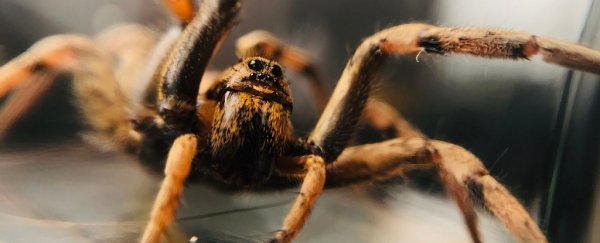Arctic wolves are fearsome predators in the icy north, but in terms of sheer biomass, the lesser known wolf spider (Pardosa lapponica) is actually the more abundant carnivore.
As the Arctic warms and summers become longer, these ferocious hunters are growing bigger and reproducing more, although that doesn't necessarily mean there will be more of these spiders in the future.
A new study suggests that as the world gets hotter, wolf spiders in Alaska might be beginning to eat each other, which could end up having a limiting effect on the size of their populations.
In fact, a summer's worth of analysis on these 8-legged critters at two different sites revealed that as female wolf spiders grow larger, juveniles in the area become more scarce.
Researchers certainly weren't expecting that, but there could be a logical explanation.
In experiments, wolf spiders are sometimes known to resort to cannibalism when surrounded by more of their kind, although real-world data on this is hard to come by.
Using stable isotope analysis, researchers at Washington University in St. Louis analysed the diets of various female spiders in the wild.
The larger spiders had different diets, consistent with what a shift towards cannibalism might look like. Further experiments in the lab confirmed that this morbid dietary shift occurred when the density of spider populations increased.
"Although cannibalism is probably not the best dietary choice for these spiders, our field and experimental data suggest that when there are lots of spiders around, they turn to cannibalism more frequently," explains global change ecologist Amanda Koltz.
"It's likely a reflection of increased competition among the spiders for resources."
If female spiders produce more offspring, then that means more competition among their young, and the authors think this phenomenon could be triggering higher rates of cannibalism in the wild.
By reducing the number of spiders that survive to adulthood, cannibalism could end up regulating wolf spider populations in a changing world.
"Cannibalising on other spiders of the same species reduces competition by reducing the number of other spiders around," Koltz says.
"But evidence from other studies has shown that wolf spiders that are only fed other wolf spiders don't live as long as those that eat a more varied diet."
If that's true, it suggests even the wolf spiders living to adulthood wouldn't be as strong or as fit as they once used to be. This could all spell bad news for the species, and also for the Arctic food web that their loss will necessarily impact.
The authors worry that changes in wolf spider populations could have a cascading effect on the ecosystem, reducing predation on lower trophic levels and influencing key natural processes like decomposition and nutrient cycling, including the release of carbon dioxide.
The data looked at in the study was collected over only one summer, and there's usually a high degree of seasonal variations in wolf spider populations.
As such, further studies will be needed to explore how body size and reproduction rates are impacting spiders in the Arctic over the long term, but it's something we should probably keep our eye on, and not only in this part of the world.
Spiders are a key part of many ecosystems, and it's important we know what their future looks like under the current climate crisis.
"These findings are a reminder that changes in body size – which is a widespread response to warmer global temperatures – may affect not only fecundity but also intra-specific competition among invertebrates," the authors conclude.
"Given the complex links between different components of arthropod food webs and the important roles of these animals in ecosystem functioning, a better understanding of how rapid climate‐driven shifts in body size are affecting communities and ecosystems is needed."
The study was published in the Journal of Animal Ecology.
